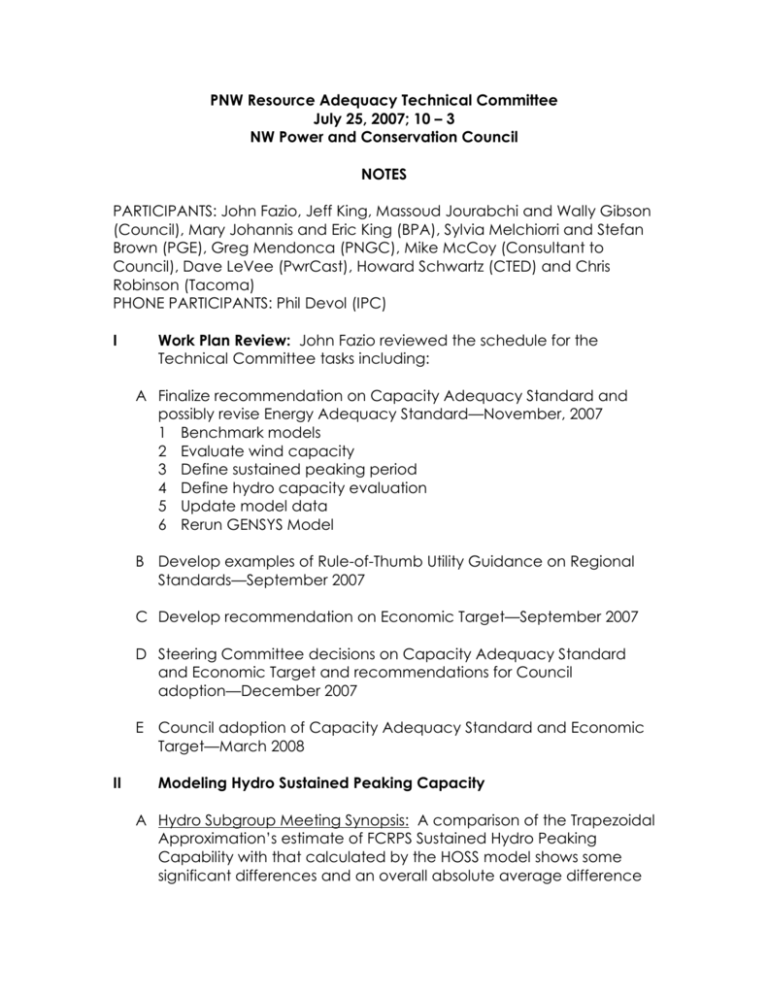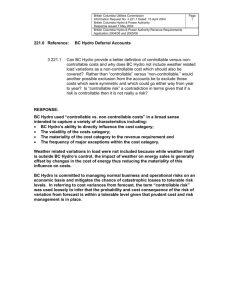7/25/07 Meeting Notes - Northwest Power & Conservation Council
advertisement

PNW Resource Adequacy Technical Committee July 25, 2007; 10 – 3 NW Power and Conservation Council NOTES PARTICIPANTS: John Fazio, Jeff King, Massoud Jourabchi and Wally Gibson (Council), Mary Johannis and Eric King (BPA), Sylvia Melchiorri and Stefan Brown (PGE), Greg Mendonca (PNGC), Mike McCoy (Consultant to Council), Dave LeVee (PwrCast), Howard Schwartz (CTED) and Chris Robinson (Tacoma) PHONE PARTICIPANTS: Phil Devol (IPC) I Work Plan Review: John Fazio reviewed the schedule for the Technical Committee tasks including: A Finalize recommendation on Capacity Adequacy Standard and possibly revise Energy Adequacy Standard—November, 2007 1 Benchmark models 2 Evaluate wind capacity 3 Define sustained peaking period 4 Define hydro capacity evaluation 5 Update model data 6 Rerun GENSYS Model B Develop examples of Rule-of-Thumb Utility Guidance on Regional Standards—September 2007 C Develop recommendation on Economic Target—September 2007 D Steering Committee decisions on Capacity Adequacy Standard and Economic Target and recommendations for Council adoption—December 2007 E Council adoption of Capacity Adequacy Standard and Economic Target—March 2008 II Modeling Hydro Sustained Peaking Capacity A Hydro Subgroup Meeting Synopsis: A comparison of the Trapezoidal Approximation’s estimate of FCRPS Sustained Hydro Peaking Capability with that calculated by the HOSS model shows some significant differences and an overall absolute average difference of 8%. The next steps to more closely align the Trapezoidal Approximation with the HOSS model are: 1 Compare head calculations 2 Compare individual projects 3 Back cast comparing historical operation and Trapezoidal Approximation 4 Revise Trapezoidal Approximation model B Trapezoidal Approximation used to Estimate Hydro Derates: John presented derates from the Trapezoidal Approximation for various sustained peaking periods. These derates could be used for reporting hydro capacity to WECC and PNUCC. Mary Johannis stated that the sustained peaking capacity derate would still need to be converted to a derate over the single peak hour metric used by WECC and proposed by Dick Adams for PNUCC reporting. Mike McCoy agreed with the need for this conversion and suggested an approach to the calculation. Wally Gibson raised the issue that there needs to be a process to get agreement from the control area operators as to how to derate hydro for the purposes of WECC reporting. He suggested the Northwest Power Pool as the forum to reach agreement on hydro derates. C Trapezoidal Approximation function in the GENESYS model: John explained that the Trapezoidal Approximation is used to help translate the monthly hydro simulation input to GENESYS to an hourly dispatch of hydro. The Trapezoidal Approximation provides the maximum capability to which the hydro system can be dispatched for a number of different sustained peaking periods. The GENESYS model breaks potential hydro generation into a number of pricing blocks with hydro generation associated with storage above flood control valued at very low price and that associated with storage below the critical rule curve valued at a very expensive price. The pricing in these blocks allows hydro to be dispatched in a reasonable manner compared with the price of other resources. D Condition under which to evaluate Hydro Capacity: Mary presented a PowerPoint suggesting that hydro capability be evaluated under a 1 in 20 event rather than evaluating hydro under critical water conditions and expected loads and then adding to that the hydro flexibility available to meet a 1 in 20 temperature event. There was a lot of discussion, which pointed out that hydro capability varies depending on the water condition AND the temperature (or load) condition. Hydro operators will set up the river system in a different way to meet heat wave/cold snap loads than to meet expected loads. Mary agreed to provide specific examples of hydro capacity calculations under different scenarios for the next meeting. III Capacity Metrics and Targets A Suggested Change to Capacity Metric: Mary discussed the 18 hour metric that BPA uses in planning FCRPS capacity and suggested this is a better metric than the 50 hour sustained peaking period because it analyzes the capacity available to meet the two highest peaks in the winter load shape and the shoulder hours. The 10 hours over 5 days metric may miss some of the peak load hours in the winter because the metric evaluates capacity available to meet 10 continuous hours. The group discussed an approach, which looks at the curtailments in GENESYS to help determine the appropriate sustained peaking period. Mary and John will follow up to see if GENESYS can be used to help answer the question, “What is the appropriate sustained peaking period?” IV Discussion of Economic Targets: John discussed the desirability of selecting an economic target as an indicator to the Region’s utilities the possible need to procure resources, even when the physical adequacy targets are met. The need to add resources would take into account the desire to avoid high prices and market volatility. A Description of Council’s Portfolio Model: John described how the Council’s Portfolio model balances costs and risks to come up with an optimum regional resource plan such as the one presented in the 5th Power Plan. This model incorporates additional uncertainties than the GENESYS model into the risk analyses including load forecast, fuel price, carbon tax and other uncertainties. A great number of model runs results in a sufficient number of simulations to enable the plotting of portfolios along the “efficient frontier” of the risk/cost curve. The physical resource adequacy standards adopted by the Council results in portfolios located on the low cost, but higher risk portion of the curve. The Council’s selection of an optimum portfolio was on the part of the curve with higher costs, but lower risks. The 5th Power Plan results in 3,000 MWa more resources than the physical standards. One option for the economic target is to use the magnitude of resources in the 5th Power Plan as the target. The shortfall of that method is the requirement that these resources be of a specific type. B Firm Resource Option: Another option for the Economic Target is to establish a load resource balance of zero JUST including resources committed to the Region, which is the philosophy used in the Northwest Regional Forecast (NRF). Howard Schwartz suggested that irrespective of the option, the methodology should take into account economic risks such as fuel prices. V Status Reports A Wind Capacity: Jeff King summarized the task of the Wind Capacity Subgroup, i.e. to re-evaluate the assumption that wind contributes 15% of its installed capacity toward meeting the capacity adequacy standard. A contract has been executed to translate wind speed data into simulated data, to perform quality control of existing wind generation data and to evaluate the contribution of wind capacity toward meeting heat wave and cold snap loads. Jeff led the group through a status of the data acquisition effort, which shows that there is, at least, some data from all sites except two. Apparently, the Council is awaiting authorization from BPA to start spending the funds. Mary said she would follow up with her contract person how to secure this authorization. Dave LeVee asked how the results of the wind capacity evaluation would be used. John indicated that instead of modeling wind as dispatchable in GENESYS, it might be better to subtract it from the load. Based on the results of the analysis, wind might be depicted differently in the Energy and Capacity Adequacy Assessments than is currently the case. The group discussed how the integration of wind might change the evaluation of hydro capacity. Dave pointed out that just using hydro to firm wind probably results in a less than optimum dispatch of hydro. B Comparison of Council’s and PNUCC’s peak hour loads: Massoud Jourabchi compared these two forecasts and noted that the Council’s initial data included too low of a forecast for DSIs, which the Council has since adjusted by elevating their DSI load to about 600 aMWs. A further comparison of peak hour loads shows that PNUCC’s estimate is still higher than that of the Council’s because of differences in economic drivers, the Council’s load is coincident whereas PNUCC’s load is non-coincident and it is likely that different methods are used to weather-normalize the load. The Council’s load estimate is at the generation site and so includes transmission losses. Presumably so does the PNUCC load forecast. VI Next Meeting: This meeting is tentatively scheduled for August 24, 2007 from 10 to 3, unless a significant number of attendees cannot make it.





